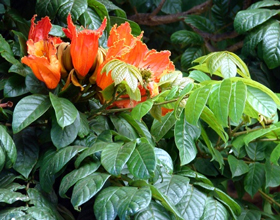|
Identification: Poison vine, aka tubaroot, is a fast growing vine that is grown in the tropics for its poisonous roots which contain a naturally occurring pesticide. This large climber has branches which are covered in brown fuzzy hairs. Each pinnate leaf is 6 in (15.2 cm) long and contains 11-15 leaflets. The pink to red pea-like flowers grow in stalked clusters.
Impacts: This aggressive vine will strangle and over-grow plants and structures. It grows into a dense canopy that will shade out all other vegetation. Poison vine is native to Southeast Asia and is grown throughout the tropics. It is recognized to be invasive in Fiji and Western Polynesia. In Hawaii, it is known to grow in only a few locations on Maui (see map) and the island of Hawaii. It is sparingly present on Kauai and Oahu (see Bishop Museum specimens). Let us know if you find this plant growing elsewhere in Hawaii.
Dispersal Mechanism: This vine reproduces from seeds and vegetatively (by cuttings or root runners). It is spread by humans who plant it for use as a pesticide.
|
|
African Tulip Tree (Spathodea campanulata):
African tulip tree is a widespread, non-native, weedy tree that grows throughout Hawaii. The leaves can look like poison root vine leaves. The African tulip tree has distinctive orange flowers, a woody stem, and a tree-like growth form. African tulip tree has been nominated as one of the top 100 "world's worst invaders".
|

|
|
African Tulip Tree (Spathodea campanulata)
All images this page, except where noted: Forest & Kim Starr
|
|